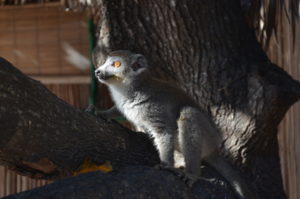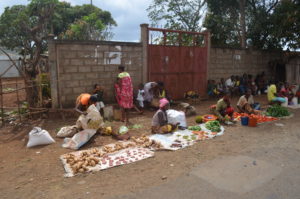03 November 2016
Madagascar Today
A fascinating and tragic country.
by Lynda Goetz
 A visit to Madagascar is a fascinating, amazing and at the same time a slightly depressing experience. If you mention ‘Madagascar’ to most English-speakers they will probably have one of two images spring to mind; either the Dreamworks cartoon film of the same name with the ring-tailed lemur, King Julian, and an incongruous cast of penguins and African animals; or alternatively, perhaps, David Attenborough in a forest talking gently about the amazing and unique flora and fauna of the island, including lemurs, chameleons and baobab trees. Whilst the latter clearly bears some relationship to the reality, which the former of course does not, Madagascar today is not the natural wonderland many of us might have imagined in our dreams.
A visit to Madagascar is a fascinating, amazing and at the same time a slightly depressing experience. If you mention ‘Madagascar’ to most English-speakers they will probably have one of two images spring to mind; either the Dreamworks cartoon film of the same name with the ring-tailed lemur, King Julian, and an incongruous cast of penguins and African animals; or alternatively, perhaps, David Attenborough in a forest talking gently about the amazing and unique flora and fauna of the island, including lemurs, chameleons and baobab trees. Whilst the latter clearly bears some relationship to the reality, which the former of course does not, Madagascar today is not the natural wonderland many of us might have imagined in our dreams.
For those whose geography is a little shaky, Madagascar is a large island off the east coast of Africa opposite Mozambique. It is the fourth largest island in the world (about two and a half times the size of the UK) and had a population of some 23 million in 2014, according to the CIA World Factbook. It is home to a massive number of unique indigenous species, having split from mainland Africa more than 100 million years ago, leaving native species to evolve independently. Humans did not arrive on the island until less than 2,000 years ago when it is believed to have first been colonised by people from the Indonesian archipelago, who arrived by outrigger. Africans, it is thought, arrived at a later date.
Today the Malagasy population is very diverse with twenty-one different ethnic groups or tribes united by a common language, if not common customs. (Hilary Bradt’s guide offers an excellent introduction to every aspect of this captivating country: see also www.wildmadagascar.org). Throughout the centuries Madagascar has been a magnet for traders and colonisers and by the early nineteenth century local rulers were playing off French and British interests to promote their own positions. King Radama I, a Merina ruler, managed, with the help of the British, to bring much of the island under his control and encouraged the London Missionary Society to establish schools and churches and to introduce the printing press. Throughout the nineteenth century the rulers of Madagascar swung between isolation and modernisation, but by the end of that century France managed to consolidate its hold over the island to the point where in 1894 it declared a protectorate over the entire country and made it a colony in 1896.
For the next 64 years the French, not without difficulties, kept control over the country until President Tsiranana was elected in 1959 and Madagascar was declared a fully independent sovereign state in 1960. Madagascar’s first president managed to survive, amidst increasing political unrest, until 1972. Since then the longest-ruling leader was Lieutenant-Commander Ratsiraka, a young naval officer who was named head of state after a coup in 1975. He ruled until 1991 and then again from 1996 until 2002. Since that time there have been various attempts to make the country more democratic, but riots and political unrest in 2009 resulted in yet another coup, since when the country appears to have been in political turmoil amidst the mounting disillusionment and increasing poverty of the general population.
Arriving at the international airport of Ivato, just outside the capital, Antananarivo, was like something out of a stand-up comedy sketch or a YouTube offering – not very funny when you are in the middle of it. It took just over an hour and a half to get out of an airport smaller than Southampton or Exeter. First there was the completion of health declarations, then the purchase of a 30-day visa (in Euros – you can’t buy any of the local currency, arriary, until you are in the country); then the utter chaos whilst five minor officials at one small counter try to process all the foreign passengers on the incoming plane. Having already been subjected to two and a half hours of queueing and newly installed biometric processing during our transfer in Jo’burg after a sleepless overnight flight, this example of incompetent bureaucracy did not seem like a good start to our stay.
Feelings of dismay did not disappear after being mugged for euros by baby-wielding beggars whilst our driver went to pay for parking, then we crawled through the capital at between 10 and 20mph passing gun-toting soldiers literally every 50 metres. Yes, we knew the political situation in the country was not great, but had not imagined things had deteriorated quite this far. It transpired that the reason for the proliferation of AK-47s was the fact that Madagascar had the honour of hosting the Pan African conference, so the presence of numerous dictators and ministers in one place required the presence of at least an equal number of young soldiers. This was probably also the reason our Air Madagascar flight scheduled for 06.10 am the next day was rescheduled for 11.35, thus completely messing up the following day’s timetable. After all, far more convenient to have time for a meeting or breakfast before embarking on your flight and what is the point of having power if you can’t arrange things to suit you? This hypothesis seemed to be borne out the following morning, as we sat in the dusty traffic jam (ignoring all attempts to sell us selfie sticks, nut bars and fly papers through the window) on our way to the airport and were passed by a fleet of Mercedes with outriders. Apparently Air Mad (as it is somewhat appropriately called) is notorious for alterations and cancellations for these and many other reasons. Mura, mura, or maura, maura, as the Malagasy would say; essentially, ‘slowly, slowly’ or the equivalent of a pragmatic shrug of the shoulders.
Slowly is generally the only way most Malagasy roads can be driven. The N6, on which we were travelling, is considered to be a ‘good’ road. It was not only full of serious potholes which necessitated continual swerving (dangerous in the face of oncoming beer lorries and speeding overladen buses topped with cartons and sacks) but in places consisted of nothing more than stretches of dust. We had decided, given the time available and the size of the country, that we would only attempt to ‘do’ the north of the island. Most British travellers, particularly those intent on more intrepid adventures tend to go for the south and west, partly because there are more national parks and partly because it is slightly less ‘touristy’. In the north, Nosy Be is the tourist island, served by direct flights from Milano and Jo’burg. There are quite a lot of Italian and French tourists and French is still the alternative language for educated Malagasy.
 The first thing that strikes you as you fly over the country towards the central international airport is the barrenness of what is now called ‘The Red Isle’. The smoke from numerous fires spirals up into the air and the red soil spreads in every direction. Where are the forests for the celebrated wildlife? Deforestation is a major problem and of international concern and it is said that 90% of the island’s original forest has now gone; the causes and diagnosis are complex. The traditional slash and burn agricultural policy known as tavy may have been outlawed, but it continues still, as we were to see at close hand during our visit. The extreme poverty of much of the population, 80% of whom live in rural areas, many at subsistence level, actually increased between 2001 and 2010, according to a report by the IMF (https://www.imf.org/external/pubs/ft/scr/2015/cr1525.pdf) and both education and access to health care has declined. As we stood and watched an out of control tavy approach alarmingly close to our lodge on the edge of the Ankarana reserve, I learnt from a guide that not only is the problem poor economic growth compared with other Sub-Saharan African countries, but also the incredibly low tax revenue ratio of the country, which amounts to only around 10% of GDP. Over the brief two weeks of our visit we were to learn a great deal about this fascinating island, its people and its unique flora and fauna. We would come away with some enduring memories and some great photos and a very real sense of the resilience of human beings and the fragility of the environment we seem increasingly to be despoiling.
The first thing that strikes you as you fly over the country towards the central international airport is the barrenness of what is now called ‘The Red Isle’. The smoke from numerous fires spirals up into the air and the red soil spreads in every direction. Where are the forests for the celebrated wildlife? Deforestation is a major problem and of international concern and it is said that 90% of the island’s original forest has now gone; the causes and diagnosis are complex. The traditional slash and burn agricultural policy known as tavy may have been outlawed, but it continues still, as we were to see at close hand during our visit. The extreme poverty of much of the population, 80% of whom live in rural areas, many at subsistence level, actually increased between 2001 and 2010, according to a report by the IMF (https://www.imf.org/external/pubs/ft/scr/2015/cr1525.pdf) and both education and access to health care has declined. As we stood and watched an out of control tavy approach alarmingly close to our lodge on the edge of the Ankarana reserve, I learnt from a guide that not only is the problem poor economic growth compared with other Sub-Saharan African countries, but also the incredibly low tax revenue ratio of the country, which amounts to only around 10% of GDP. Over the brief two weeks of our visit we were to learn a great deal about this fascinating island, its people and its unique flora and fauna. We would come away with some enduring memories and some great photos and a very real sense of the resilience of human beings and the fragility of the environment we seem increasingly to be despoiling.
(to be continued)
If you enjoyed this article please share it using the buttons above.
Please click here if you would like a weekly email on publication of the ShawSheet

